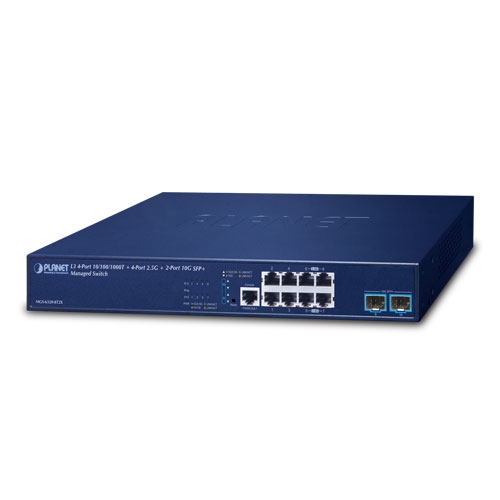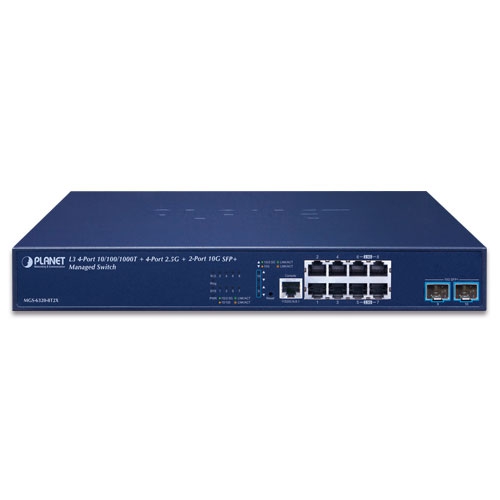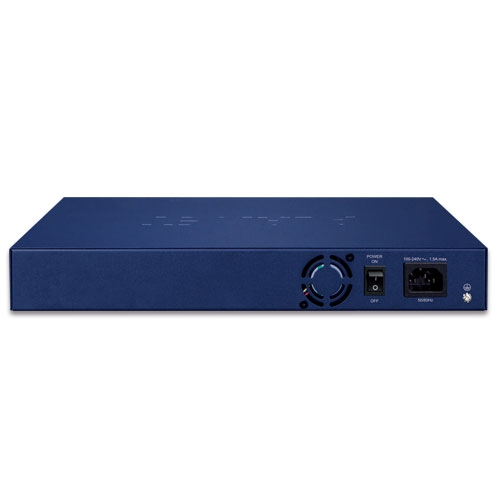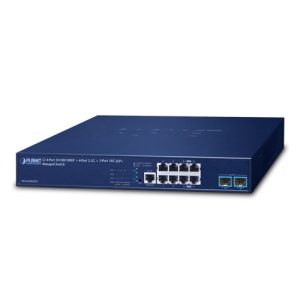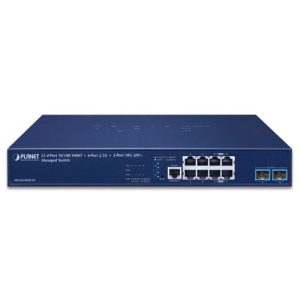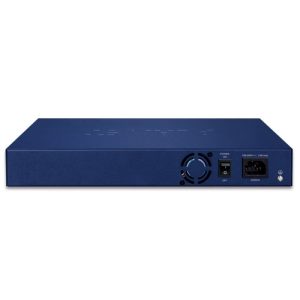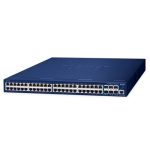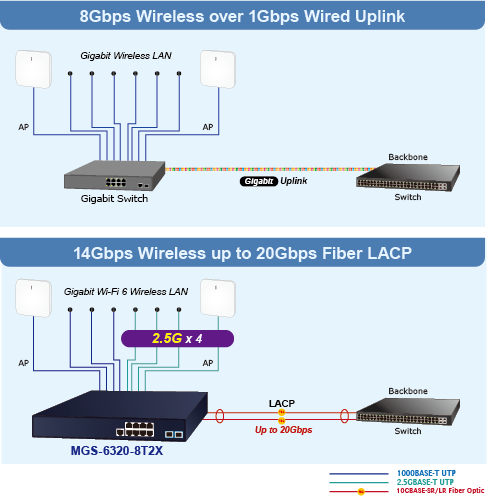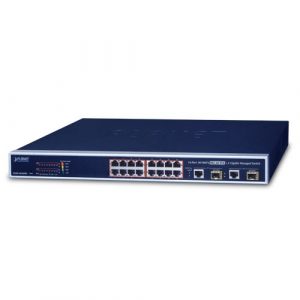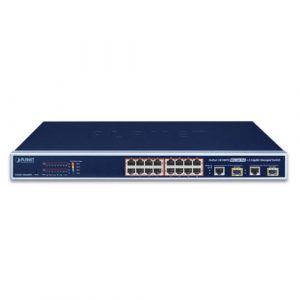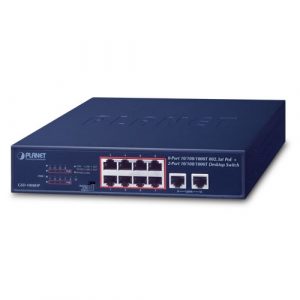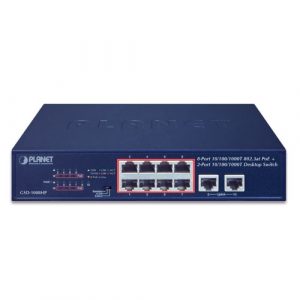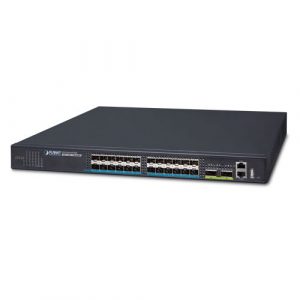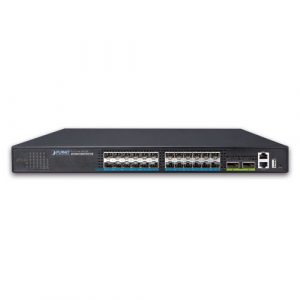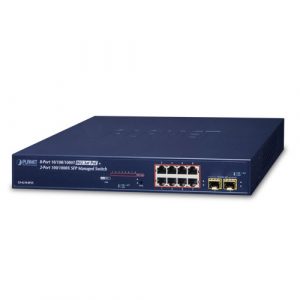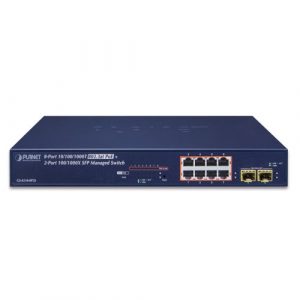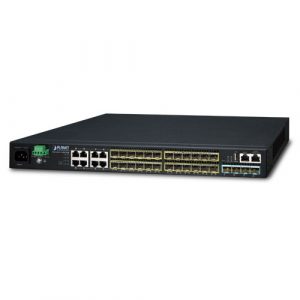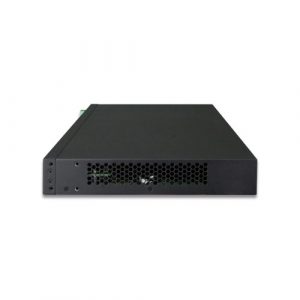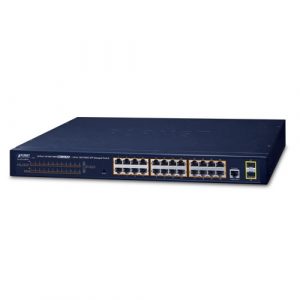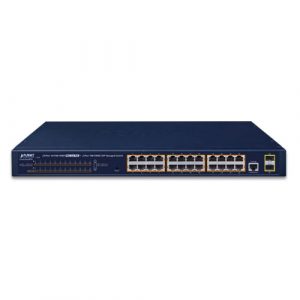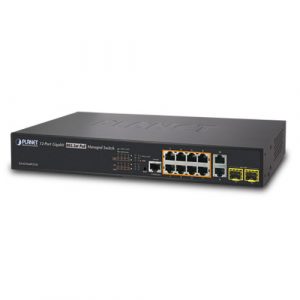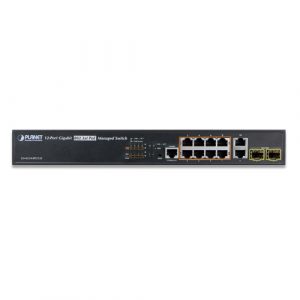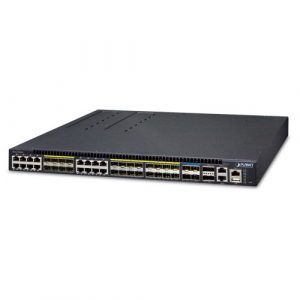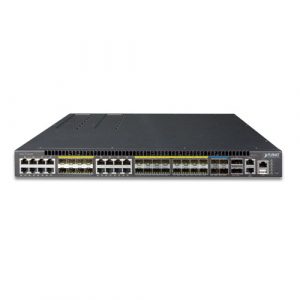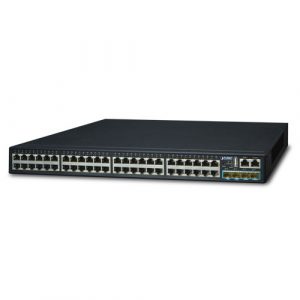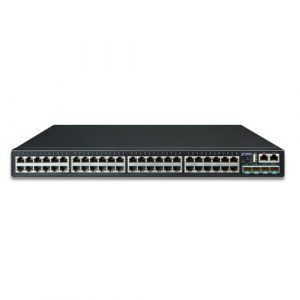- Applicazioni
- SPECIFICHE
- DOWNLOAD
Descrizione
Switch multigigabit gestito perfetto con commutazione L3/L2 e sicurezza
PLANET MGS-6320-8T2X è uno switch multigigabit completamente gestito progettato per la richiesta di apparecchiature di rete richieste con larghezza di banda elevata, come AP wireless Wi-Fi 6 802.11ax, NAS, workstation e quelli con interfacce 2.5GBASE-T. È dotato di 4 porte in rame 10/100/1000BASE-T, 4 porte in rame 100/1000/2500BASE-T e 2 porte in fibra 1G/2,5G/10GBASE-X SFP+ progettate in modo flessibile per estendere la distanza di connessione. Con una capacità di collegamento dati così favorevole, prestazioni di routing Layer 3 basate su hardware, motore di commutazione Layer 2 e Layer 4 e interfacce di gestione IPv6/IPv4 intuitive ma avanzate, aiuta ad accelerare l’implementazione dell’IoT di prossima generazione e della rete wireless per le imprese e le città intelligenti.
Capacità di 2,5 Gbps per applicazioni con larghezza di banda diversificata
MGS-6320-8T2X ha la capacità di raggiungere un’alta velocità di 2,5 Gbps su interfacce in rame che aiuta ad accelerare le prestazioni della trasmissione di dati di grandi dimensioni. Non vi è alcun limite di larghezza di banda quando si utilizza l’AP wireless, il NAS o il computer di prossima generazione con i cavi Ethernet CAT5e esistenti, riducendo così i costi e i problemi di ricablaggio. Può sicuramente darti la velocità che richiedi e il suo Plug and Play semplifica l’installazione.
Anello ridondante, ripristino rapido per applicazioni di rete critiche
MGS-6320-8T2X supporta la tecnologia ad anello ridondante e dispone di una potente e rapida capacità di ripristino automatico per prevenire interruzioni e intrusioni esterne. Incorpora la tecnologia avanzata ITU-T G.8032 ERPS (Ethernet Ring Protection Switching) e il protocollo Spanning Tree (802.1w RSTP) nella rete del cliente per migliorare l’affidabilità del sistema e il tempo di attività in ambienti difficili. In una determinata rete ad anello semplice, il tempo di ripristino potrebbe essere inferiore a 10 ms per riportare rapidamente la rete al normale funzionamento.
Applicazione di routing statico VLAN di livello 3
Con i robusti protocolli di instradamento del traffico IPv4/IPv6 Layer 3 integrati, MGS-6320-8T2X garantisce un instradamento affidabile tra VLAN e segmenti di rete. I protocolli di routing possono essere applicati dall’interfaccia VLAN con un massimo di 1K voci di routing. L’MGS-6320-8T2X è sicuramente una soluzione conveniente e ideale per le aziende.
Soluzione Hotspot Wi-Fi con infrastruttura di rete estesa per spazi pubblici
MGS-6320-8T2X è dotato di design non bloccante, dimensioni desktop e moduli in fibra ottica SFP, offrendo all’infrastruttura di rete una maggiore flessibilità ma costi inferiori. Fornendo quattro porte 2500BASE-T e due interfacce SFP+ da 10 Gigabit, MGS-6320-8T2X può facilmente creare un sistema di autenticazione di rete su controller LAN wireless per le aziende. Ad esempio, può funzionare con il controller wireless e il server RADIUS per garantire una sicurezza completa per l’autenticazione degli utenti wireless con AP potenziati.
Supporto del routing di livello 3
MGS-6320-8T2X consente all’amministratore di aumentare comodamente l’efficienza della rete configurando manualmente il routing statico VLAN IPv4/IPv6 Layer 3, automaticamente le impostazioni RIP (Routing Information Protocol) o OSPF (Open Shortest Path First).
Il RIP può utilizzare il conteggio dei hop come metrica di routing e prevenire i loop di routing implementando un limite al numero di hop consentiti in un percorso dall’origine alla destinazione.
L’OSPF è un protocollo di routing dinamico interno per sistemi autonomi basato sullo stato del collegamento. Il protocollo crea un database per lo stato dei collegamenti scambiando stati dei collegamenti tra gli switch Layer3, quindi utilizza l’algoritmo Shortest Path First per generare una tabella di routing basata su quel database.
Gestione efficiente
Per una gestione efficiente, MGS-6320-8T2X è dotato di interfacce di gestione console, Web e SNMP.
- Grazie all’interfaccia di gestione integrata basata sul Web, offre una funzionalità di gestione e configurazione semplice da usare e indipendente dalla piattaforma.
- Per la gestione basata su testo, è possibile accedervi tramite Telnet e la porta della console.
- Per il software di monitoraggio e gestione basato su standard, offre una connessione SNMPv3 che crittografa il contenuto del pacchetto ad ogni sessione per una gestione remota sicura.
| Hardware Specifications | |
|---|---|
| Copper Ports | 4x 10/100/1000BASE-T RJ45 auto-MDI/MDI-X interface with Port-1 to Port-4 4x 10/100/1000/2500BASE-T RJ45 auto-MDI/MDI-X interface with Port-5 to Port-8 |
| SFP+ Slots | 2 x 1G/2.5G/10GBASE-X SFP interfaces with Port-9 to Port-10 |
| Console | 1 x RJ45-to-DB9, RS232 serial port (115200, 8, N, 1) |
| Reset Button | < 5 sec: System reboot > 5 sec: Factory default |
| RAM | 512Mbytes |
| Flash Memory | 64Mbytes |
| Dimensions (W x D x H) | 330 x 150 x 44.5mm, 1U height |
| Weight | 1436g |
| Power Requirements | 100~240V AC, 50/60Hz, 1.5A max. |
| Power Consumption | Max. 9.9 watts/33.76BTU (Power on without any connection) Max. 18.48 watts/63.02BTU (Full loading) |
| ESD Protection | 6KV DC |
| Surge Protection | 4KV DC |
| LED | System: PWR (Green), SYS (Green), R.O (Green), Ring (Green) Per 10/100/1000BASE-T RJ45 Interfaces (Port 1 to Port 4): 1000 LNK/ACT (Green) 10/100Mbps LNK/ACT (Amber) Per 10/100/1000/2500BASE-T RJ45 Interfaces (Port 5 to Port 8): 1000/2500Mbps LNK/ACT (Green) 10/100Mbps LNK/ACT (Amber) Per SFP+ Interfaces (Port 9 to Port 10): 1G/2.5G LNK/ACT (Green) 10G LNK/ACT (Amber) |
| Switching Specifications | |
| Switch Architecture | Store-and-Forward |
| Switch Fabric | 68Gbps/non-blocking |
| Throughput | 50.59Mpps@ 64Bytes packet |
| Address Table | 8K entries, automatic source address learning and aging |
| Shared Data Buffer | 4.1Mbits |
| Flow Control | IEEE 802.3x pause frame for full-duplex Back pressure for half-duplex |
| Jumbo Frame | 10Kbytes |
| Layer 3 Functions | |
| IP Interfaces | Max. 32 VLAN interfaces |
| Routing Table | Max. 32 static route entries Max. 1K routing table entries |
| Routing Protocols | IPv4 RIPv2 IPv4 OSPFv2 IPv6 OSPFv3 IPv4 hardware static routing IPv6 hardware static routing |
| Layer 2 Functions | |
| Port Configuration | Port disable/enable Auto-negotiation 10/100/1000Mbps full and half duplex mode selection Flow Control disable/enable Port link capability control |
| Port Status | Display each port’s speed duplex mode, link status, flow control status, auto negotiation status, trunk status |
| Port Mirroring | TX/RX/Both Many-to-1 monitor Supports up to 5 sessions |
| VLAN | IEEE 802.1Q tag-based VLAN, IEEE 802.1ad Q-in-Q tunneling Private VLAN Edge (PVE) MAC-based VLAN Protocol-based VLAN Voice VLAN MVR (Multicast VLAN Registration) GVRP Up to 4K VLAN groups, out of 4094 VLAN IDs |
| Link Aggregation | IEEE 802.3ad LACP (static trunk) Supports 4 trunk groups with 10 ports per trunk |
| IGMP Snooping | IPv4 IGMP (v1/v2/v3) snooping IPv4 IGMP querier mode support Supports 255 IGMP groups |
| MLD Snooping | IPv6 MLD (v1/v2) snooping, IPv6 MLD querier mode support Supports 255 MLD groups |
| Bandwidth Control | Per port bandwidth control Ingress: 10Kbps~13000Mbps Egress: 10Kbps~13000Mbps |
| Ring | Supports ERPS, and complies with ITU-T G.8032 Recovery time < 10ms @ 3 nodes Recovery time <50ms @ 16 nodes Supports Major ring and sub-ring |
| QoS | Traffic classification based, strict priority and WRR 8-level priority for switching Port number 802.1p priority 802.1Q VLAN tag DSCP/TOS field in IP packet |
| Security Functions | |
| Access Control List | IP-based ACL/MAC-based ACL ACL based on: MAC Address IP Address Ethertype Protocol Type VLAN ID DSCP 802.1p Priority Up to 512 entries |
| Security | Port security IP source guard, up to 512 entries Dynamic ARP inspection, up to 1K entries Command line authority control based on user level Static MAC address, up to 64 entries |
| AAA | RADIUS client TACACS+ client |
| Network Access Control | IEEE 802.1x port-based network access control MAC-based authentication Local/RADIUS authentication |
| Management Functions | |
| Basic Management Interfaces | Console;Telnet; Web browser; SNMP v1, v2c |
| Secure Management Interfaces | SSHv2, TLSv1.2, SNMPv3 |
| System Management | Firmware upgrade by HTTP protocol through Ethernet network Configuration upload/download through HTTP Remote Syslog System log LLDP protocol NTP PLANET Smart Discovery Utility PLANET CloudViewer app |
| Event Management | Remote Syslog System log SMTP |
| SNMP MIBs | RFC1213 MIB-II RFC 2863 IF-MIB RFC1643 Ethernet MIB RFC2863 Interface MIB RFC2665 Ether-Like MIB RFC2737 Entity MIB RFC2819 RMON MIB (Groups 1, 2, 3 and 9) RFC2618 RADIUS Client MIB RFC3411SNMP-Frameworks-MIB IEEE802.1X PAE LLDP MAU-MIB Power over Ethernet MIB |
| Standards Conformance | |
| Regulatory Compliance | FCC Part 15 Class A, CE |
| Standards Compliance | IEEE802.3 10BASE-T IEEE802.3u 100BASE-TX IEEE802.3z 1000BASE-SX/LX IEEE 802.3ab 1000BASE-T IEEE 802.3bz 2.5GBASE-X IEEE 802.3ae 10Gb/s Ethernet IEEE802.3x flow control and back pressure IEEE802.3ad port trunk with LACP IEEE802.1D Spanning Tree Protocol IEEE802.1w Rapid Spanning Tree Protocol IEEE 802.1s Multiple Spanning Tree Protocol IEEE802.1p Class of Service IEEE802.1Q VLAN tagging IEEE 802.1x Port Authentication Network Control IEEE 802.1ab LLDP IEEE 802.3af Power over Ethernet IEEE 802.3at Power over Ethernet Plus RFC 768 UDP RFC 793 TFTP RFC 791 IP RFC 792 ICMP RFC 2068 HTTP RFC 1112 IGMP v1 RFC 2236 IGMP v2 RFC 3376 IGMP v3 RFC 2710 MLD v1 RFC 3810 MLD v2 RFC 2328 OSPF v2 RFC 2453 RIP v2 |
| Environments | |
| Operating | Temperature: 0 ~ 50 degrees C Relative Humidity: 5 ~ 95% (non-condensing) |
| Storage | Temperature: -10 ~ 70degrees C Relative Humidity:5 ~ 95% (non-condensing) |



